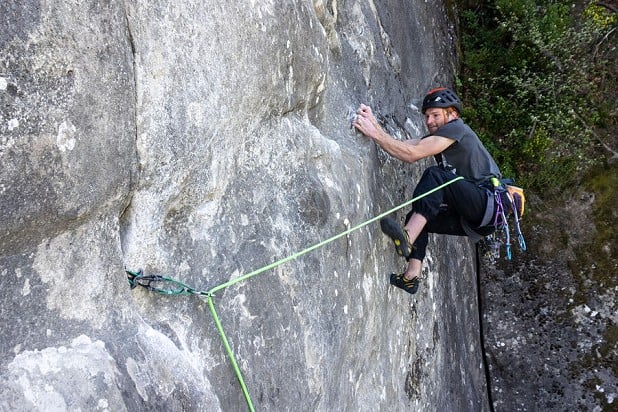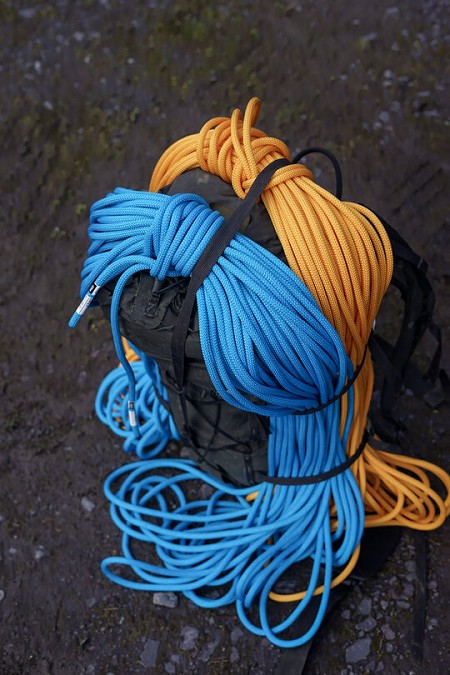Will Rupp is a British climber and photographer with a wealth of experience ranging from alpine climbing and big walling, to hard trad and sport lines. We sent a selection of our ropes from Gilmonte, a Slovakian rope manufacturer, for Will to put to the test to see what these ropes are really made of. Read on to find out about Will's travels with the Ace 9.0 and Gill 8.3, only available at Sgùrr Shop.
Written by Will Rupp
INTRODUCTION
Gilmonte Ropes isn't a brand that many people have heard of within the UK. However, they provide a cost effective option to many of the bigger brands. For the past few months, I tested a pair of Gilmonte half ropes and a triple rope in a variety of settings, to try and gauge how they handled and held up in a multitude of situations. I have been using Gilmonte ropes for everything from alpine winter climbing, big wall multi-pitching, dry tooling, sport climbing and single pitch trad climbing.
As a Slovakian brand with little known repertoire within the UK, I was keen to see how the ropes handled against the more established brands I normally use. The ropes I have been using are the Gilmonte Ace 9.0mm triple-rated rope along with the Gilmonte Gill 8.3mm twin & half rope.
TEST AREAS
The first test of these ropes was dry tooling. The best use of the wet weather and a friend's finger injury we could think of. Not being too dexterous in a pair of oversized boots and crampons meant the ropes routinely got stood on in the mud at Masson Lees. After trying my hand at some Welsh and Scottish Winter routes this season, dry tooling felt like the perfect next step for improvement. Climbing Sick Boy (D9) with Adam Bowman doing Sub Rosa (D10+).
After this, it was time to test the half ropes at Pen Trwyn. Going the wrong way on Chain Gang and taking quite a large fall above the gear, the stretch in the ropes was noticeable. Both giving a soft catch but disposing me worrying close to the floor. Falling on the skinny single rope was a similar experience. After falling from the very top of Strawberries for seemingly the 100th time it was decided that heading to Raven Tor to gain some fitness was much required.
Reuben and I then headed off to the Alps. Reuben being the more alpine climber, and I thinking of myself as more of a summer rock head, but after doing a couple of VIIs this season I felt I'd be in good stead. Renting a Fiat 500 from Geneva and bivving between the cemetery and the public toilet we felt the itch for some routes. After skinning up for Beyond Good and Evil and being shut down due to conditions we headed up to the Midi. After camping on the Plan d'Aiguille a good day climbing, going considerably off route on M6 Solar we fled to the shack after all our kit had frozen the previous night. Waking up in horrendous conditions we headed up to the sanctuary of the Aiguille du Midi lift station. Getting stuck up there as the lifts could not run the ropes made a nice base for the chess board.
Verdon, Saint-Leger, Aiglun (a hidden gem) and Annot were next on the list. Annot being a particularly amazing venue if you're a fan of perfect cracks. Some of the run-outs also allowed the ropes to take some sizeable falls.
Up next was Taghia, big wall sport climbing in Morocco. It's hard to describe how good this place with. 20 pitches of well bolted limestone on pristine rock is hard to come by. Some highlights included Fantasia, a 600m 7c taking 19 hours gite to gite. The only route we regretted doing was Rouge Berbere, a horrendously loose 14 pitch 7b trad, this taking 24 hours from gite to gite, a big day. It was slightly concerning that this had been onsight soloed by Alex Honnold seeing as how rarely climbed and dangerous it is.
Coming back to the UK the fitness felt good and Point Blank, Knock Yourself Out and Ghost Train were dispatched at Pembroke, Midsummer Night's Dream and Great Wall at Cloggy, and Positron at Gogarth.
After this I felt a rest was needed and we headed off to the Tre Cime to climb the Hasse-Brandler. 18 pitches of beautiful Italian choss, I'd never seen so many pegs on a route. With incoming thunderstorms we fled to Cadarese to climb some cracks. An underrated destination, it was one of the best trad destinations I've been to.
GILMONTE ACE 9.0mm
The first thing you'll notice about this rope is its colour. The first time I took this rope to the wall it immediately caught everyone's attention. It's like a fluorescent fishing line attached to the climber. The rope is treated to both prevent the ingress of dirt into it and is dry treated. This treatment was noticeable as there was little adverse effect on the rope after being dragged through the base of many dusty European crags as the rope bag was forgotten at home.
Although a 9.0mm rope wouldn't immediately be my first choice as a wall rope, its lightweight nature made it easy to fit into a bag to cycle to the wall. It gave a noticeable soft catch and flowed through the GriGri, making belaying simple but also giving a reassuring catch.
I often found myself taking the rope on single pitch trad days. Using it as a single on harder direct trad routes or folding it over into a half rope (making use of its triple rope rating). It was reassuring on long run outs to have a rope both rated as a half and a single.

The dark middle marker compared to the brightness of the rope made the rope easy to fold over when needed. the slight caveat being that the middle marker did fade over extended use but always stayed visible. On harder sport routes the lightweight nature made the rope easy to clip with little rope drag. Although the downside of this is that it takes slightly more effort to grab onto the rope when redpointing.
The rope came into its own on big multi-pitches with long walk-ins. When paired with a tagline it was undoubtedly the best multi pitching rope I've used. Knowing if you get caught in a storm the rope wasn't going to get completely sodden was a bonus!
One thing I'm normally concerned about with skinny ropes is their durability. I'm often pretty tough on my ropes, taking multiple falls a session, abseiling over edges to strip gear, take photos, and jumaring on them when required. The Gilmonte Ace hasn't become fluffy and I am yet to feel the need to cut either of the ends due to wear.

Having never owned a triple rated rope before I often found myself pairing this rope up with one of the Gilmonte Gills. Normally when pairing a single with a half, or using two singles in guide mode the ropes are hard to feed through the belay device. These two ropes combined were easy to use without having to yard them through the device.
When travelling in Europe and wanting to use a single but also needing two ropes for some routes it was far easier to carry two ropes whilst backpacking than three separate ropes. This gave the ability to sport climb on the single and use doubles when needed for abseiling.
GILMONTE GILL 8.3mm
The Gilmonte Gills are rated as half and twin ropes also with the same dry treatment. The ropes are perfect for general UK cragging, multi-pitching and where more durability or lifespan is required than a skinnier pair of ropes.
Although not the skinniest ropes on the market they're perfect for Scottish winter where the ropes run over multiple edges, for alpine climbing they feel reassuring, but I would be tempted for a lighter pair.
The ropes fared very well from being inadvertently stood on by multiple crampons and dipped in the sea, on sea cliff abseils. The ropes felt supple in the hand and the thick weave on the sheath made them feel like a tough pair of ropes.
The dry treatment of the ropes meant that they didn't freeze when used in an alpine setting. However, a longer review is needed to see how this changes with repeated use.
One bonus to having a thicker rope is it's often more confidence-inspiring when you really are just on one rope to catch your fall. On a route like Point Blank, where there's one piece of gear holding you off the ground with a big runout, it's nice to feel confident in your rope. The ropes took several big falls on individual half ropes, and apart from being noticeably more stretchy than a single there was little difference. The ropes held well in the belay plate.
SUMMARY
These ropes held up well to all I could throw at them, and I tried my best. I used them in as many styles and routes as I could. The one thing that struck me about them was their durability. Even under extended harsh use, they were phenomenally undamaged. The only criticism is the weight of the half ropes, but this is only a negative for big walk-ins and alpine climbs. The single Ace 9.0 rope has become my daily, and although a little on the skinny side, it's something I've quickly gotten used to. Taking photos of the ropes was a joy as they really stand out in a variety of backgrounds. Although the middle marker has faded, this happens and can be resolved. So overall I would recommend these ropes and it's always nice to support a small UK distributor!
In the market for a new rope? Check out Gilmonte ropes on Sgùrr Climbing Shop.













